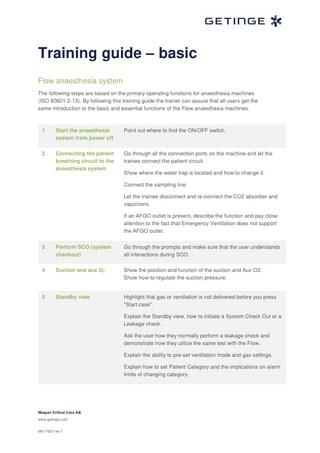Basic Training Guide
2 Pages

Preview
Page 1
Training guide – basic Flow anaesthesia system The following steps are based on the primary operating functions for anaesthesia machines (ISO 80601-2-13). By following this training guide the trainer can assure that all users get the same introduction to the basic and essential functions of the Flow anaesthesia machines.
1
Start the anaesthesia system from power off
Point out where to find the ON/OFF switch.
2
Connecting the patient breathing circuit to the anaesthesia system
Go through all the connection ports on the machine and let the trainee connect the patient circuit. Show where the water trap is located and how to change it. Connect the sampling line. Let the trainee disconnect and re-connect the CO2 absorber and vaporizers. If an AFGO outlet is present, describe the function and pay close attention to the fact that Emergency Ventilation does not support the AFGO outlet.
3
Perform SCO (system checkout)
Go through the prompts and make sure that the user understands all interactions during SCO.
4
Suction and aux O2
Show the position and function of the suction and Aux O2. Show how to regulate the suction pressure.
5
Standby view
Highlight that gas or ventilation is not delivered before you press "Start case". Explain the Standby view, how to initiate a System Check Out or a Leakage check. Ask the user how they normally perform a leakage check and demonstrate how they utilize the same test with the Flow. Explain the ability to pre-set ventilation mode and gas settings. Explain how to set Patient Category and the implications on alarm limits of changing category.
Maquet Critical Care AB. www.getinge.com MX-7423 rev 1
6
Setting fresh gas flow and concentration
Explain the function of the membrane buttons and turning/accepting settings with the rotary knob. Explain why you can’t deliver 100% O2 and agent on a Flow.
7
Manually ventilating the patient
Explain the APL-valve function – highlight that it is electronically controlled meaning it will not work in case of machine failure.
8
Setting ventilation control parameters
Show direct access buttons and ventilation settings tab.
9
Switching between ventilation modes
Show how to choose or change the ventilation mode.
10
Setting agent concentration
Explain how the vaporizer is activated. Explain how to switch anaesthesia agent. Show how to fill the vaporizer.
11
Gas concentrations measurements
Explain where the gas analyser measurements is shown on screen, how to distinguish from inspiratory and expiratory etc.
12
Ventilation parameter measurements
Explain where the ventilation parameter measurements are shown on screen and what they represent.
13
Alarm limits
Explain how the alarms are shown on screen. Show the different ways of accessing the Alarm Profile window. Show how to change alarm limits. Explain the difference in alarm limits due to patient category.
14
End case
Explain how to end a patient case and the implications of the choice made in the "End case window".
15
Emergency ventilation
Describe and show the function in detail, pay special attention to: a. No anesthetic agent delivery during emergency ventilation b. The difference between Emergency Ventilation APL-valve and the electronic (normal) APL If AFGO outlet is present, clarify that is not functioning during emergency ventilation.